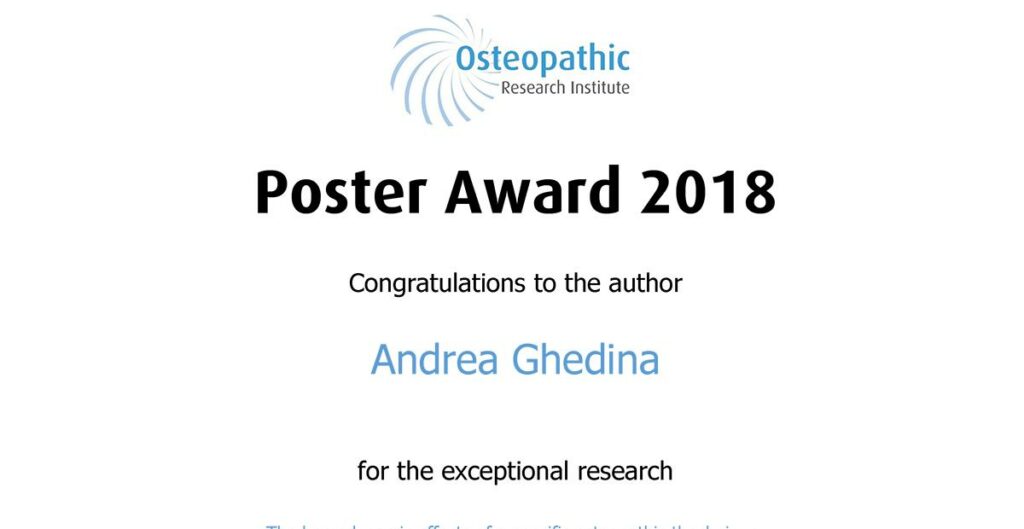Author: Andrea Ghedina (M.Sc. Ost.), Italy
Introduction
- The study tests the effect of an osteopathic protocolled technique, applied on specific arterial points of the lower limbs.
- This study aims to test if the technique, conducted through the arterial pulse wave, shows a measurable hemodynamic effect both locally, through the common femoral arteries in the lower limb region and on the arterial system as a whole.
- The autonomic (1), the fascial (2) and the pulsatory (3,4) theoretical models converge towards an hypothesis of an integrated mechanism of self-regulation of the arterial system. The technique uses the arterial system through the phenomenon of the pulse wave to induce functional changes of the system – Osteopathic Manual Treatment-Arterial Pulse Wave (OMT-APW) -.
Methods
- Double Blinded Randomized Controlled Trial
- 44 subjects were enrolled, whereof 42 completed the study (17 males, 25 females; age range = 25-65; mean age = 52 years, SD = 9.61). The subjects were randomly assigned to the experimental group, which received the OMT-APW protocol, or to the placebo group, which underwent light touch as placebo treatment.
- For all the subjects five parameters were measured: systolic peak, systolic peak-diastolic peak mean value, blood flow velocity, ankle brachial index (ABI) and cardio ankle vascular Index (CAVI).
- Data were collected for all subjects in two different sessions: immediately before (T1_pre) and after (T1_post) the first session and one week later, immediately before (T2_pre) and after the second session (T2_post).
Results
No difference between the groups was found. However, within the experimental group (and not in the placebo group) a statistically significant decrease of the index CAVI SX both in T1 (Z = – 1.96, p <.50) and in T2 (Z = -2.34 ; p <.50) is observed. The CAVI DX index and the index ABI DX decrease statistically significantly (respectively Z = -2.32; p <.905 and Z = -2.70, p <.01), but this difference is observed only in T2 and not in T1.
Conclusion
- The OMT-APW treatment produced a statistic significant change only in some of the parameters within the experimental group. These parameters give an indication of global system responses rather than local ones.
- The fact that CAVI and ABI decrease, however, represents a good starting point to support the hypothesis of regional and systemic blood influence.
- CAVI is an important index for arterial stiffness. Further studies should test the protocol on the whole arterial network.
- Different works show the relationship between wave speed and the incidence of cardiovascular attacks (5,6). In light of these data, it becomes even more important carrying on the research towards the systemic response to the registered data on the main network points of the arterial system. The aim is to understand the impact that this work could have in the modification of arterial stiffness parameters evidenced by the pulse wave velocity (PWV) behavior.
Literature
(1) Liu J., Cao T.S., Duan Y.Y., Yang Y.L., Yuan L.J.(2011). Effects of cold pressor-induced sympathetic stimulation on the mechanical properties of common carotid and femoral arteries in healthy males. Heart and vessels. 26(2):214-21.
(2) Massin M.M., Meains K., Withofs N., Ravet F., Gerard P. (2000) Circadian Rhythm of Heart and Heart Rate Variability. Arch Dis Child. 83:179-182
(3) Tozzi P. (2012). Selected fascial aspects of osteopathic practice. Journal of bodywork and movement therapies 16(4):503-19
(4) Elemerich S. (2013) Cardiac Waves, Brain Waves, and the Making of Quantities into Qualities. Current Anthropology Vol. 54 (Suppl.7)
(5) Chirinos J.A., Kips J. G., Jacobs D. R., Brumback L., Duprez D. A, Kronmal R., Bluemke D. A., Townsend R. R., Vermeersch S., Segers P. (2012) Arterial Wave Reflections and Incident Cardiovascular Events and Heart Failure. Journal of the American College of Cardiology. 60 (21)
(6) Covic A., Siriopol D. (2015) Pulse Wave Velocity Ratio. The New “Gold Standard” for Measuring Arterial Stiffness. Hypertension. 2015;65: 289- 290


